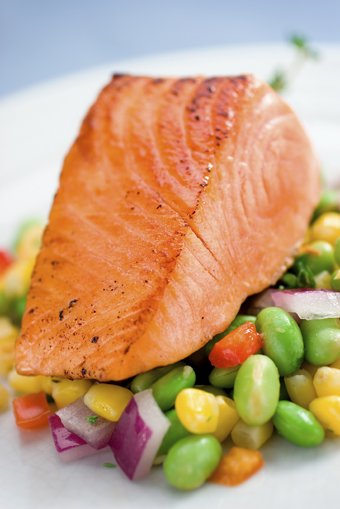Edamame: Whole Food Fun
My first love for edamame began when I started frequenting Japanese restaurants. They served steamed edamame at the table instead of bread. They are served steamed in their pods as a fun finger food that takes longer to eat, so you can enjoy them without filling up too much. Edamame, an unprocessed soy food, can be beneficial to your health. But with all the confusion about soy, most of us aren't taking advantage of this unprocessed, delicious superfood. Woman are afraid it will give them breast cancer and men are worried soy will negatively affect their sexual health.
Edamame nutrition
Edamame are simply unripe green soybeans, containing 30 - 45% more protein than other protein-rich members of the bean family. Unlike beans and lentils, this protein has all the essential amino acids, similar to the protein found in animal sources, but it comes without the cholesterol and saturated fat of animal products. In fact, it's packed with both soluble and insoluble fibers, omega-3 fatty acids, vitamins, and minerals. Soybeans also have the highest concentration of the isoflavones class of phytonutrients. It's these loads of isoflavones in soy which have led to most of the commotion about this little bean, given their estrogen-like effects.
Let's set the record straight, since there is so much confusion about soy, even among health providers. Most of the problems related to soy come from studies using rats and mice. We now know that rodents metabolize soy isoflavones very differently than humans, essentially making the conflicting studies immaterial. Fortunately, now we have more human studies researching women’s food intake and other lifestyle factors affecting breast cancer recurrence, both from the United States and Asia. These studies found eating soy lowered the risk of breast cancer recurrence of almost 10,000 breast cancer patients survivors. Although to a lesser extent, these results were true even for women with estrogen receptor positive breast cancer, regardless of whether they were taking tamoxifen.
While isoflavones may operate like estrogen, they also have compounds that fight estrogen, so they can block estrogen from binding to its receptor. Plus, they stop the formation of estrogens in fat tissue and increase production of a protein that binds estrogen in the blood, so it's less available to bind to the receptor. They also have antioxidant and anti-inflammatory properties that may work to reduce cancer growth. The 2012 American Cancer Society’s Nutrition and Physical Activity Guidelines for Cancer Survivors sums it up by concluding that current research finds no harmful effects caused by breast cancer survivors consuming soy.
While high doses of isoflavones have been shown to decrease male rats’ ability to reproduce, that effect hasn’t been found in male humans. In fact, in nine clinical studies looking at isoflavone exposure on circulating estrogen levels, none found that isoflavone supplements or isoflavone-rich soy affected total or free testosterone levels in men. Therefore, the fear that soy causes feminization in men is unfounded.
There is clinical evidence to back up claims that soy helps reduce the risk of heart disease, osteoporosis, and some forms of cancer. But much of this research has had to compete with misunderstood animal findings. Many clinical studies have reported that soy foods and soy protein positively affect heart disease, but because of limited or inconsistent data, no health-related conclusions can be made. The discrepancies in study results may be related to the source of the soybeans being used. How it's processed can affect bioactive compounds and the soy's ability to lower cholesterol. While animal research with soy reacted very differently in animals, it's interesting to note that the more processed the soy product used in studies, the more tumor growth occurred in animals.
Where is soy found?
Soy comes in lots of forms: from naturally-grown pods to highly processed soy isolate, often found in products trying to increase protein content artificially. Minimally processed whole foods are critical for our health, and it's no different with soy. In fact, the highest concentrations of the isoflavones are found in soy foods that aren’t highly processed (such as edamame, tofu, tempeh, soy milk, soy nuts, and miso). However, even processed soy flour and textured soy protein contain significant amounts of isoflavones, but highly processed soy foods such as soy ice cream, snack bars or hot dogs have much lower amounts of isoflavones than whole soy foods like edamame. To make sure soy has not been genetically engineered, choose organic soy which exclude genetic engineering. These soy foods state on the label that they are ‘organic’ or ‘made from non-GMO soybeans'.
Edamame, as a whole food without processing, is the best choice to take advantage of soy's large amount of quality, plant-based protein. It's also loaded with nutrition from vitamins, minerals, fiber, and phytonutrients, all of which boost our health. It’s a nearly perfect food and an excellent way to start moving to a more plant-based diet. Accept October's Healthy Challenge and eat edamame. Found both with and without the pod in the frozen section and sometimes the produce section of your grocery store, they're cooked, so no preparation is needed. Add them to all your recipes. I especially like them in my pilafs and rice bowls; they're mild with a pleasant taste. They go well with any whole grain recipe as well as soups and salads, and they are especially good as a snack when warm in the pod. The edamame slips right out of the pod and into your mouth. Even kids enjoy eating them. Snack on this super food without any worries!


